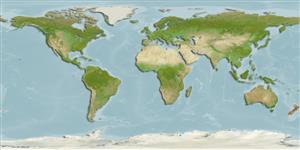>
Gobiesociformes (Clingfishes) >
Gobiesocidae (Clingfishes and singleslits) > Haplocylicinae
Etymology: Gastroscyphus: Greek, gaster = stomach + Greek, kyphos = curved, bent (Ref. 45335); hectoris: Named after Sir James Hector, natural historian and Director of the Colonial Museum (Ref. 9003).
More on author: Günther.
Environment: milieu / climate zone / depth range / distribution range
Ekologi
marina bottenlevande; djupintervall 0 - 10 m (Ref. 9003). Temperate
Southwest Pacific: endemic to New Zealand.
Size / Vikt / Age
Maturity: Lm ? range ? - ? cm
Max length : 6.4 cm SL hane/ej könsbestämd; (Ref. 9003); rapporterad maxålder: 4 år (Ref. 9003)
Short description
Morfologi | Morfometri
Taggstrålar i ryggfenan (totalt): 0; Mjukstrålar i ryggfenan (totalt): 6-8; Taggstrålar i analfenan 0; Mjukstrålar i analfenan: 6 - 7. Color uniform or blotched reddish to olive green or brown dorsally, paler ventrally. A bar of lighter color along the head between the eyes and a narrow horizontal dark stripe from the snout to the gill cover separating the darker dorsal pigment from the paler lower surface. Occasionally a variable row of white spots along the side of the body. Distinguished from other clingfish by its distinctive body form (robust and tapers abruptly behind the dorsal and anal fins).
Commonly amongst brown algae (Cystophora) in rock pools at the low tide level and subtidal areas. Sometimes found on seaweed exposed at low tide. Swims towards cover and positions itself like drifting algae (heads up tail down position, sculling with the pectoral fins) when disturbed.
Life cycle and mating behavior
Könsmognad | Reproduktion | Lek | Ägg | Fecundity | Larver
Paulin, C. and C. Roberts, 1992. The rockpool fishes of New Zealand (Te ika aaria o Aotearoa). Museum of New Zealand (Te Papa Tongarewa). 177 p. (Ref. 9003)
IUCN Red List Status (Ref. 130435)
Threat to humans
Harmless
Human uses
Ytterligare information
PopulärnamnsynonymerMetabolikPredatorerEkotoxikologiReproduktionKönsmognadLekSpawning aggregationFecundityÄggEgg development
Age/SizeTillväxtLength-weightLength-lengthLength-frequenciesMorfometriMorfologiLarverLarvdynamikRekryteringAbundansBRUVS
referenserVattenbrukVattenbruksprofilAvelslinjerGenetikElectrophoresesÄrftlighetSjukdomarBehandlingNutrientsMass conversion
MedarbetareBilderStamps, Coins Misc.LjudCiguateraHastighetSimsättGälytaOtolithsHjärnstorlekSyn
Verktyg
Special reports
Download XML
Internet-källor
Estimates based on models
Preferred temperature (Ref.
123201): 13.8 - 18.3, mean 16.4 °C (based on 99 cells).
Phylogenetic diversity index (Ref.
82804): PD
50 = 1.0000 [Uniqueness, from 0.5 = low to 2.0 = high].
Bayesian length-weight: a=0.00398 (0.00161 - 0.00982), b=3.13 (2.91 - 3.35), in cm total length, based on LWR estimates for this (Sub)family-body shape (Ref.
93245).
Trofisk nivå (Ref.
69278): 3.3 ±0.3 se; based on size and trophs of closest relatives
Resiliens (Ref.
120179): Mellan, lägsta populationsfördubblingstid 1,4-4,4 år (tmax=4).
Fishing Vulnerability (Ref.
59153): Low vulnerability (10 of 100).
